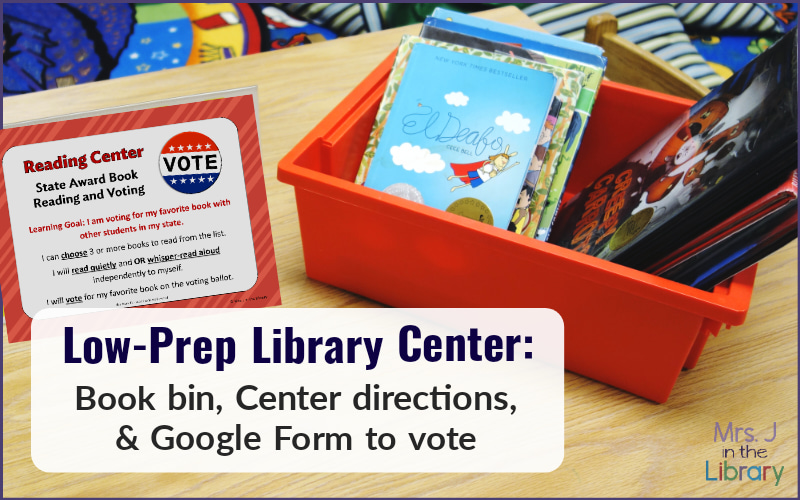Around October of each school year (after library orientation), I introduce the Pennsylvania Young Reader’s Choice voting contest to my students in kindergarten through 2nd grade. I read a selection of books from an annually-updated book list, and then students get to vote for their favorite one. As in many other U.S. states, there are a few lists of nominations, divided by grade level: Kindergarten to 3rd grade, 3rd to 6th grade, 6th to 8th grade, and Young Adult.
Each year, I read aloud the books on the K-3 list to the students in kindergarten, 1st grade, and 2nd grade. Though I don’t have time to read every book on the list to every grade level, I do read more than half of them so that every student is eligible to vote. After listening to the book, students check out books, and with any extra time, they have a reading response activity to do in Google Classroom. They also fill in the number of stars (out of 5) they want to give a book.
For older elementary students, I promote the voting contest with the State Award Book Voting Library Center and giving students time to explore the different books on their grade level’s list.
Disclaimer: This post contains affiliate links, which means if you purchase an item after clicking the link, I will receive a small commission. See Disclosures & Disclaimers for more information.
The State Award Book Voting Center in action:

 What Your Students are Learning and Doing:
What Your Students are Learning and Doing:
At this center, the focus is on reading and enjoying the books at the center, either independently or with friends.
Usually, students only need to read a few of the books on the list to vote for their favorite book. Luckily, the list for Grades 3-6 in Pennsylvania always includes a few picture books, so I gather them and the longer chapter books from the nominations list into a large book bin. These books stay in the bin for the duration of the voting contest, which can be several months.
Of course, I let students check out these books too, but I put a note in our circulation software (Destiny) and set it to show every time the book is scanned. When the book comes back, that note pop-up reminds me to put it back in the center’s book bin.
I keep the books on the K-3 list separate to use with my read-aloud lessons, but as I finish reading them, I add them to a different book bin for students in older grades to read too.

 How Students are Assessed:
How Students are Assessed:
There is no formal assessment other than students’ participation by submitting their vote.
I like to use a Google Form to collect the votes, with book cover images as the responses. You can set the Form to only allow 1 vote per students by using the “collect email addresses” option in Google Forms (recommended for schools with Google Workspace, formerly GSuite for Education).
 What You (the Teacher-Librarian) are Doing:
What You (the Teacher-Librarian) are Doing:
During the library class, all you need to do is walk around the room to monitor student behavior. This is probably no different than any other library class.
 What You Need (see Amazon Idea List):
What You Need (see Amazon Idea List):
- Books on your state’s award nominations list(s) in a large book bin
- 1 or 2 large plastic book bins (Gratnell medium “trays” are what I use.)
- The State Award Book Voting Center, including center sign with directions to remind students of what to do, and many copies of paper ballots
- If you prefer digital voting, create a Google Form to share with students so they can vote for their favorite book. You can use LibraryThing.com to get the book cover images to use under educational use and fair use.
- Optional – Library Centers Management Tracking Booklets / Menus and Learning Badge Stickers, a printable booklet for each student that you can add stamps or stickers to,
OR Library Centers DIGITAL Menu / Tracker with Learning Badges, a digital way to track students’ progress through a center assignment and/or keep students accountable for their center choices using Google Classroom or Google Drive.
More Helpful Resources
 Where to find your state’s book nominations list:
Where to find your state’s book nominations list:
Check the website for your state’s library association, or school library association. Look for words like “student choice” or “young readers” or just “award” to find out which books are on this year’s list for your students.
For example in Pennsylvania, the PA Young Reader’s Choice contest is run by the Pennsylvania School Librarians Association, or PSLA. It’s separate from PaLA, which is the Pennsylvania Library Association. Your state or local area likely has a professional organization for librarians, and maybe even one specifically for K-12 school librarians.
Consider joining as a member to connect with other teacher-librarians and library professionals who can support you and help you grow! My state’s school library association has been a tremendous source of relevant professional development through conferences and events that are specifically for teacher-librarians.
What strategies or promotion ideas do you use for your state’s student book voting contest?
Share your ideas in the comments or wherever you see this post.